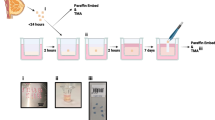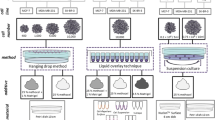Summary
This study was based on the hypothesis that after tumour transplantation, fibroblast metabolism increases adjacent to a tumour and this increase correlates with an increase in certain components of the extracellular matrix. A serial histochemical study of the cellular metabolism and extracellular matrix in a fast-growing mammary rat carcinoma was designed. The model used was theN-nitrosomethylurea-induced adenocarcinoma. At 24, 48, 72 or 96 h after transplantation, tumours and surrounding tissues were excised and processed. Ribonucleic acid and succinate dehydrogenase stains were used to indicate cellular metabolism; the extracellular matrix was stained for collagen, elastin, acid mucopolysaccharides, mucoproteins, glycoproteins and glycolipids. The results of this histology were compared with the histology of nonneoplastic transplants.
In subcutaneous tissue adjacent to neoplasia, fibroblasts were abundant and showed an increase in metabolism between 24–96 h; this was correlated with an increase in collagen. For nonneoplastic transplants, fibroblasts were present only at 96 h, and collagen increases did not occur.
It is inferred from the results that the tumour transplant is responsible for the increase in fibroblast metabolismin vivo which in turn increases fibre production.
Similar content being viewed by others
References
Angello, J. C., Danielson, K. G., Anderson, L. W. &Hosick, H. L. (1982) Glycosaminoglycan synthesis by subpopulations of epithelial cells from a mammary adenocarcinoma.Cancer Res. 42, 2207–10.
Baumann, H. &Held, W. A. (1981) Biosynthesis and hormone-regulated expression of secretory glycoproteins in rat liver and hepatoma cells.J. biol. Chem. 256, 10145–55.
Black, M. M., Zweifach, B. W. &Speer, F. D. (1953) Tetrazolium Salts-A new tool in general and experimental pathology.Am. J. clin. Path. 23, 332–9.
Chayen, J., Bitensky, L. &Butcher, R. G. (1973) The histochemistry of selected dehydrogenases. InPractical Histochemistry, pp. 188–93. London: Wiley & Sons.
Dunphy, J. E. &Udupa, K. N. (1955) Chemical and histochemical sequences in the normal healing of wounds.New Engl. J. Med. 254, 847–51.
Gridley, M. F. (1951) A modification of the silver impregnation method of staining reticular fibers.Am. J. clin. Path. 21, 897–9.
Gullino, P. M., Pettigrew, H. M. &Grantham, F. H. (1975)N-nitrosomethylurea as mammary gland carcinogen in rats.J. natn. Cancer Inst. 54, 401–9.
Harbers, E., Domagk, G. F. &Muller, W. (1968) Control of metabolism. InIntroduction to Nucleic Acids: Chemistry Biochemistry and Functions, pp. 247–55 New York: Reinhold.
James, K. (1977)The Macrophage and Cancer (edited byJames, K., Mcbride, B. andStuart, A.), p. 225. Edinburgh: European Reticuloendothelial Society.
Levine, E. M., Becker, Y., Boone, C. W. &Eagle, H. (1965) Contact inhibition, macromolecular synthesis, and polyribosomes in cultured human diploid fibroblasts.Proc. natn. Acad. Sci. U.S.A.,53, 350–6.
Lillie, R. D. &Fulmer, H. M. (1976)Histopathologic Technic and Practical Histochemistry, pp. 165–216 and pp. 679–718 New York: McGraw-Hill Book Co.
Liotta, L. A. (1982) Tumor extracellular matrix. (Editorial.)Lab. Invest. 47, 112–3.
Luna, L. G. (1968)Manual of Histologic Staining Methods of the Armed Forces Institute of Pathology, 3rd edn, pp. 72–99 and pp. 153–73 New York: McGraw-Hill Book Co.
Postlethwaite, A. E., Snyderman, R. &Kang, A. H. (1976) The chemotactic attraction of human fibroblasts to a lymphocyte-derived factor.J. exp. Med. 144, 1188–203.
Sakakibara, K., Suzuki, T., Motoyama, T., Watanabe, H. &Nagal, Y. (1982) Biosynthesis of an interstitial type of collagen by cloned human gastric carcinoma cells.Cancer Res. 42, 2019–27.
Takeuchi, J. (1966) Growth-promoting effect of acid mucopolysaccharides on Ehrlich ascites tumor.Cancer Res. 26, 797–802.
Tibor, B. &Anderson, P. I. (1963) Carbohydrates. InHistochemistry: Theory, Practice and Bibliography, pp. 65–95. New York: Harper & Row Publishers, Inc.
Todaro, G., Matsuya, Y., Bloom, S., Robbins, A. &Green, H. (1967) Stimulation of RNA synthesis and cell division in resting cells by a factor present in serum.Wistar Institute Symposium Monographs 7, 87–101.
Author information
Authors and Affiliations
Rights and permissions
About this article
Cite this article
Cole, M.A., Trotter, S.W. Metastatic rat adenocarcinoma: histochemical evaluation of fibroblasts and extracellular matrix. Histochem J 17, 1171–1184 (1985). https://doi.org/10.1007/BF01002500
Received:
Revised:
Issue Date:
DOI: https://doi.org/10.1007/BF01002500




